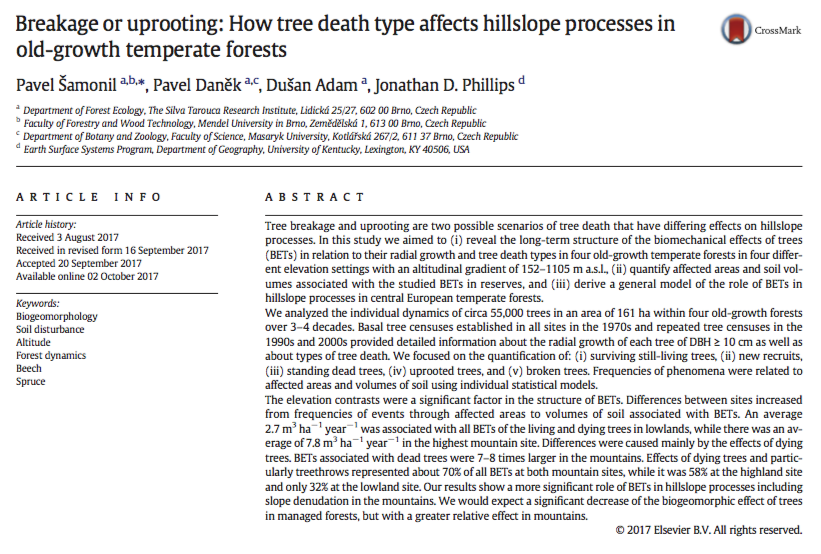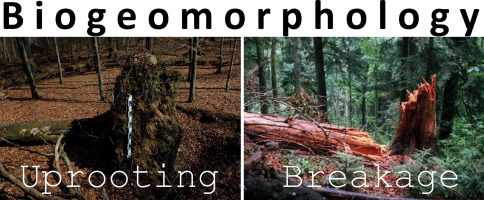UK Announces $40,000+ in Funding for International Student Exchange
By Amaya DeVicente
Last year, 18 percent of the University of Kentucky graduating class graduated with global experience. The university’s International Center has taken steps to increase that percentage.
The UK International Center’s Education Abroad and Exchanges program (UK EA) recently announced a new 2018-19 scholarship and program fee reduction initiative for selected UK exchange partners around the world, ranging from $1,000-$5,000.
BREAKAGE VS. UPROOTING & HILLSLOPE GEOMORPHOLOGY
Just published in Geomorphology:
Samonil, P., Danek, P., Adam, D., Phillips, J.D. 2017. Breakage or uprooting: how tree death affects hillslope processes in old-growth temperate forests. Geomorphology 299: 276-284.
The abstract is below:


Posted 14 November 2017
Social evolution within and between groups: reciprocity, relatedness, and synergy
Many organisms live in populations structured by space and by class, exhibit plastic responses to their social partners, and are subject to nonadditive ecological and fitness effects. Social evolution theory has long recognized that all of these factors can lead to different selection pressures but has only recently attempted to synthesize how these factors interact. Using models for both discrete and continuous phenotypes, we show that analyzing these factors in a consistent framework reveals that they interact with one another in ways previously overlooked. Specifically, behavioral responses (reciprocity), genetic relatedness, and synergy interact in nontrivial ways that cannot be easily captured by simple summary indices of assortment. We demonstrate the importance of these interactions by showing how they have been neglected in previous synthetic models of social behavior both within and between species. These interactions also affect the level of behavioral responses that can evolve in the long run; proximate biological mechanisms are evolutionarily stable when they generate enough responsiveness relative to the level of responsiveness that exactly balances the ecological costs and benefits. Given the richness of social behavior across taxa, these interactions should be a boon for empirical research as they are likely crucial for describing the complex relationship linking ecology, demography, and social behavior.
Geography Alumna Receives National Youth Warriors Against Poverty Award
By Tatyanna Pruitt
Laura Greenfield, a UK College of Arts & Science geography alumna, was recently awarded the Sargent Shiver Youth Warriors Against Poverty Leadership Award by the Marguerite Casey Foundation. The award is presented to recognize and honor the vision, passion, and dedication of young people on improving the lives of families and communities.
Eighth Annual Dimensions of Political Ecology Conference
The University of Kentucky Political Ecology Working Group invites you to participate in the eighth annual Dimensions of Political Ecology Conference (DOPE) February 22-24, 2018.
A&S Hall of Fame 2017 - Dr. Karl Raitz
Karl Raitz, Professor Emeritus, Department of Geography, University of Kentucky, received his Ph.D. from the Department of Geography at the University of Minnesota in 1970. He served as a faculty member in the UK Geography Department from 1970 until his retirement in 2013. His research and teaching interests include historical geography and cultural studies with emphasis on American landscapes, visual and qualitative methods, and a regional focus on the United States, especially Appalachia, the Upland South, and the Middle West.
How Can We Measure Social Segregation Outside of Residential Areas
On Practice Theory, or What’s Practices got to do [got to do] with it?
Ted Schatzki is Professor of Geography and Philosophy. He is also the former Senior Associate Dean in the College of Arts & Sciences, a former Chair of the Department of Philosophy, and cofounder and former codirector of the University’s Committee on Social Theory, which oversees a multidisciplinary graduate-level teaching and research program in social thought. Schatzki earned a degree in applied mathematics from Harvard University (1977) and degrees in philosophy from Oxford University (1979) and UC Berkeley (1982, 1986). His research interests lie in theorizing social life, and he is widely associated with a stream of thought called practice theory that is active today in a range of social disciplines, including geography, sociology, organizational studies, education, anthropology, international relations, and history. Schatzki is the author of four books: Social Practices (1996), The Site of the Social (2002), Martin Heidegger: Theorist of Space (2007) and The Timespace of Human Activity (2010). He has also co-edited two volumes on practice theory: The Practice Turn in Contemporary Theory (2001) and The Nexus of Practices (2017). In addition, he is author of numerous articles on such social topics as flat ontology, social space, learning, large social phenomena, art, social change, materiality, governance, and discourses, as well as many essays on human action and on the philosophies of Wittgenstein and Heidegger, Schatzki has been a research fellow of the Fulbright Commission and the Alexander von Humboldt Foundation. He has also been a visiting professor or researcher at the University of Exeter, The Max Planck Institute for the History of Science in Berlin, the Karl-Franzens University in Graz, the Institute of Advanced Studies in Vienna, Lancaster University, the University of Zurich, The Charles Sturt University in Australia, and the Catholic University Eichstaett-Ingolstadt in Germany.

